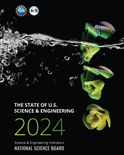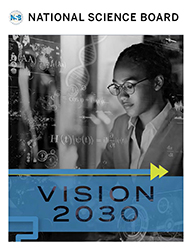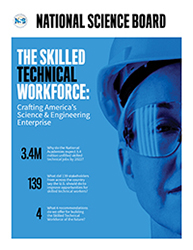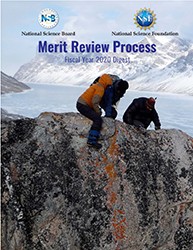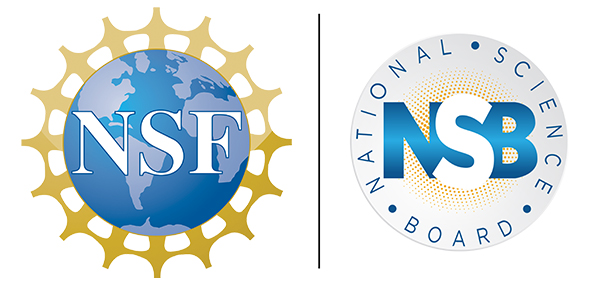
Crafting America's Science and Engineering Enterprise
New report spotlights need, opportunities for skilled technical workers

Nanotechnology students have opportunities to work with state-of-the-art equipment at an ATE center (Credit and Larger Version)
September 9, 2019
Alexandria, VA
News headlines frequently channel concern about the nation’s readiness to meet employers’ needs for workers with the science, technology, engineering, and mathematics (STEM) skills that many of today’s jobs across all sectors require. A new report released today by the policymaking board of the National Science Foundation highlights the critical contributions of skilled technical workers and urges action to boost this vital segment of the U.S. S&E workforce and open up opportunities for all Americans to participate in and benefit from advances in science and technology.
The Skilled Technical Workforce: Crafting America’s Science and Engineering Enterprise by the National Science Board (NSB) calls attention to the 17 million people who use S&E skills in their job but do not have a bachelor’s degree. These individuals bring critical thinking, design, digital, math, and coding skills to work as auto mechanics, health care technicians, electricians, welders, computer systems analysts and administrators, and operators of “smart” infrastructure. They also contribute to the nation’s S&E enterprise, accounting for more than 50% of all workers in many of America’s advanced industries.
“For too long this crucial segment of our STEM workforce has been underappreciated,” said Victor McCrary, who chaired NSB’s Skilled Technical Task Force. “And yet it has and will continue to be essential to America’s economic prosperity, our scientific and technological competitiveness, and our national security. Some projections suggest that by 2022, we will need 3.4 million more skilled technical workers in this country.”
“As advancements in science and engineering change and shape jobs across all sectors, the American worker must be front and center in our efforts to prepare the workforce of the future. This report provides a critical roadmap to develop the U.S. technically skilled workforce and places important emphasis on an enterprise-wide approach that leverages Federal programs, the private sector, and academic institutions. The Trump Administration continues its commitment to draw upon the talents of all Americans in our 21st century economy, embrace public-private partnerships, and support continued American prosperity and security for generations to come,” said Kelvin K. Droegemeier, Director, The White House Office of Science and Technology.
NSB’s report builds on its 2015 Revisiting the STEM Workforce report that called for building a strong, STEM-capable U.S. workforce. The Skilled Technical Workforce: Crafting America’s Science and Engineering Enterprise report—which complements recent efforts of Congress and the White House—recommends four actions:
- Change the Message – Counter negative perceptions and raise awareness of skilled technical workforce jobs. There are multiple pathways to career success and it is critical to avoid setting up skilled technical educational pathways and jobs as adversarial with four-year educational paths. Community colleges, work-based learning, and four-year institutions are interconnected, mutually reinforcing options for career goals.
- Focus on the Data – Collect and share data on the education, skills, and workforce characteristics of the STW to better inform consumers, develop partnerships, and leverage existing investments.
- Leverage Federal Investments – Leverage the programs and investments of Federal agencies that support STW-related programs—including NSF—through a holistic, coordinated approach.
- Build Partnerships – Education institutions should work as partners in concert with industry and government at all levels to grow the STEM-capable U.S. workforce via programs designed for the needs of their local communities.
“Many know NSF’s mission is to advance the progress of all fields of science and engineering. They may be less familiar with the agency’s mandate to prepare the STEM workforce of the future, including the skilled technical workforce,” said France Córdova, NSF Director. “In addition to our Advanced Technical Education program, which educates highly qualified S&E technicians for advanced technology fields through community college support, NSF supports the STW in numerous other ways, such as through education research and our Convergence Accelerator on the Future of Work.”
The NSB held five listening sessions around the country to hear directly from over 200 individuals hailing from 65 locations throughout the U.S. Participants in these listening sessions included faculty and students at community colleges and technical schools, regional and local industry leaders, and local policymakers. Board members were struck by the compelling human portrait of the challenges with which workers, students, educators, and business owners in the STW contend as well as with the opportunities to do more.
“K-12 schools, 2-year colleges, 4-year colleges and universities, and other education and workforce development programs are all integral, synergistic parts of a whole that we need to foster a STEM-capable workforce,” said NSB Chair Diane Souvaine. “We need these educational institutions to work together and with business and industry to create partnerships that are tailored to the needs of local communities.”
Additional NSB resources on the skilled technical workforce are available here, including congressional testimony, listening sessions, and video clips.
About the National Science Board
The National Science Board and the National Science Foundation's Director jointly head NSF. NSB identifies issues critical to NSF's future and establishes the agency’s policies within the framework of applicable national policies set forth by the President and the Congress. The Board also serves as an independent body of advisors to both the President and the Congress on policy matters related to science and engineering and education in science and engineering. In addition to major reports, the NSB publishes occasional policy briefs or statements on issues of importance to U.S. science and engineering. NSB’s 24 members are appointed by the President for six-year terms and selected for their eminence in research, education and records of distinguished service.
Media Contact: Nadine Lymn, 703-292-2490, nlymn@nsf.gov
Useful NSB Web Sites:
Home Page: http://www.nsf.gov/nsb
Media Contact: http://www.nsf.gov/staff/staff_bio.jsp?lan=nlymn&org=NSF
News: http://www.nsf.gov/nsb/news
Meetings: http://www.nsf.gov/nsb/meetings
Publications: http://www.nsf.gov/nsb/publications
Facebook: https://www.facebook.com/NationalScienceBoard
Twitter: Twitter: https://twitter.com/intent/user?screen_name=NSF_NSB
YouTube: https://www.youtube.com/channel/UCkrHRzuGSrPp2haQs0T_Pww
To view PDF documents, please download Adobe Acrobat Reader.
